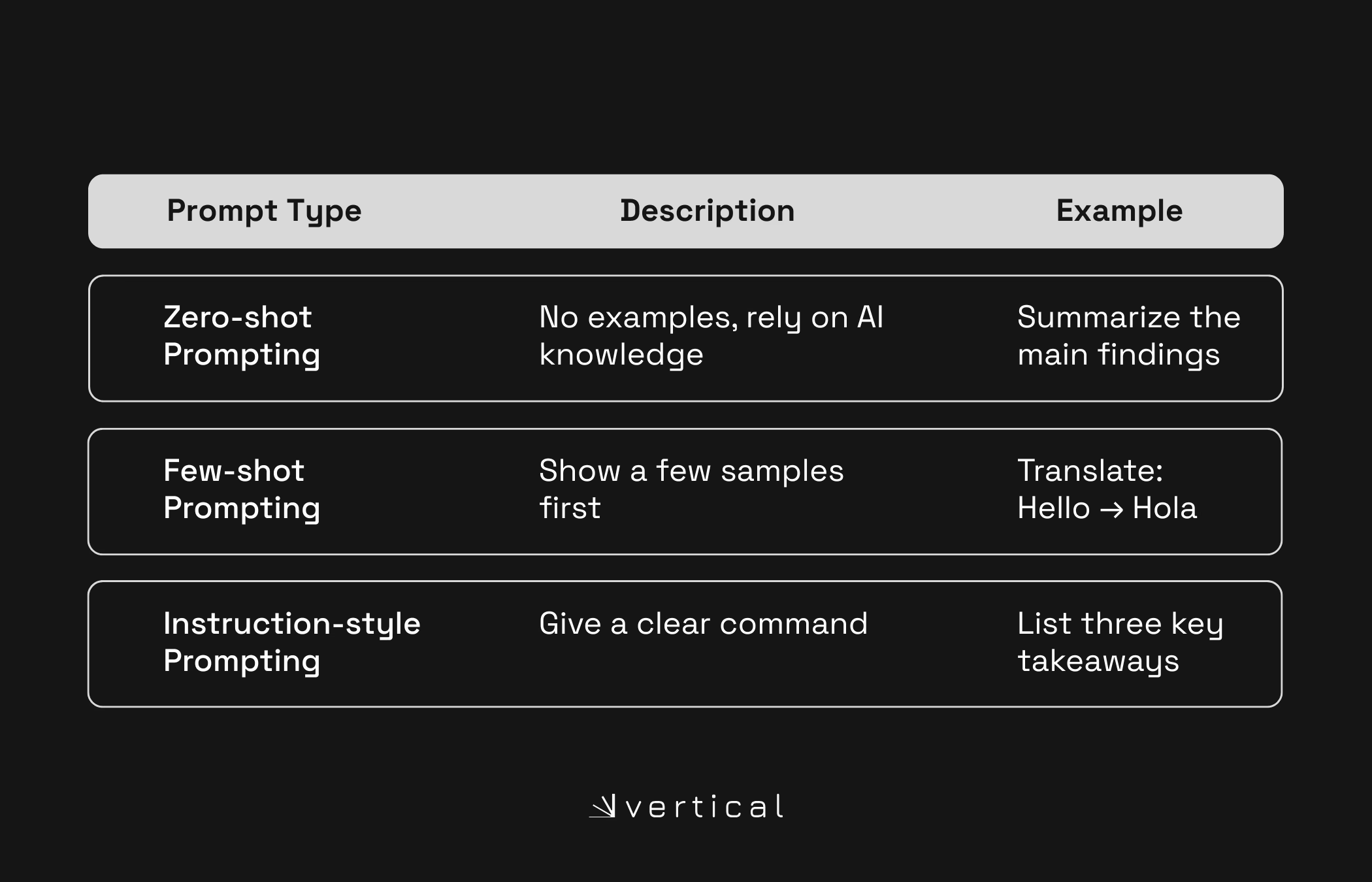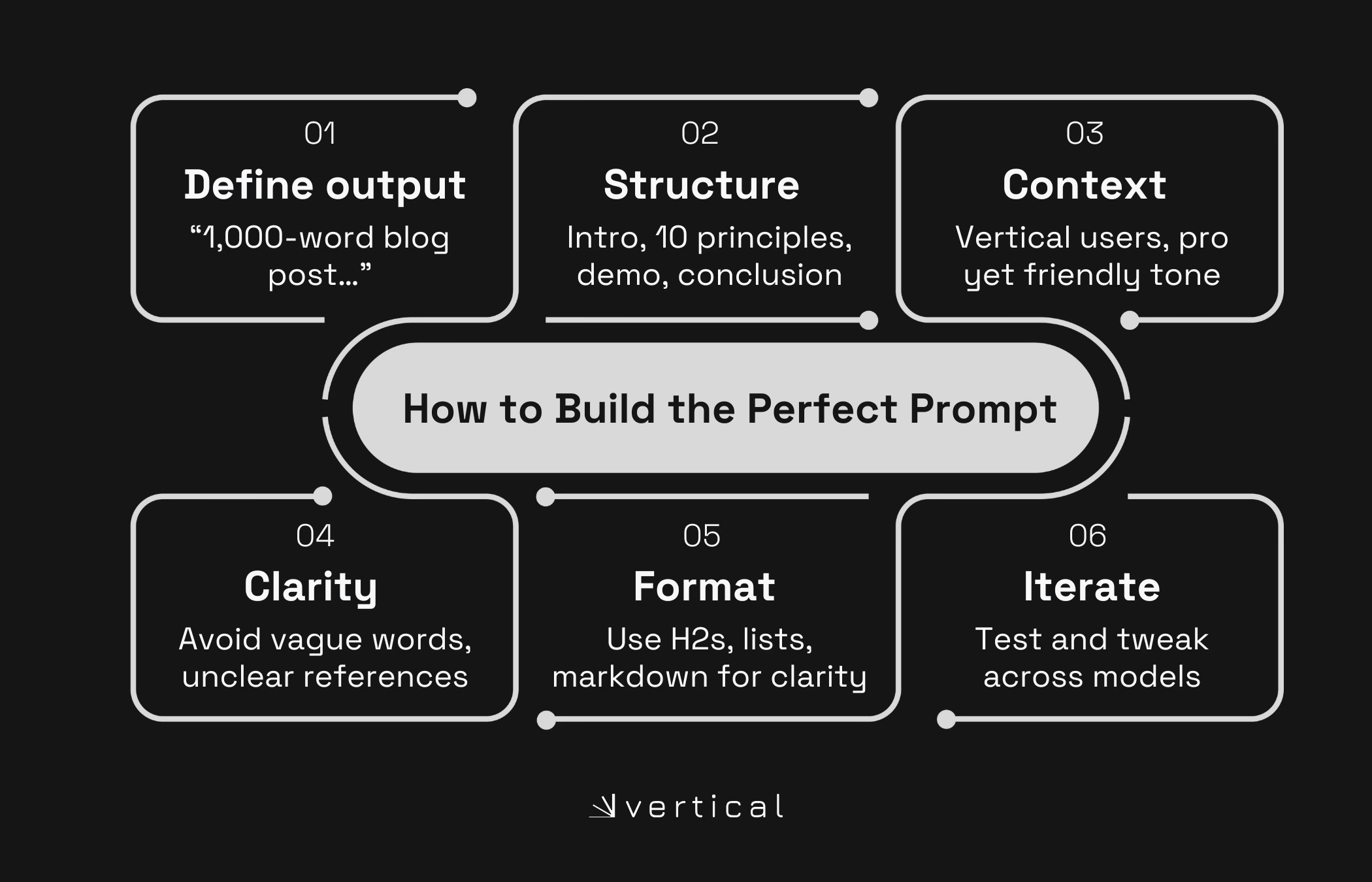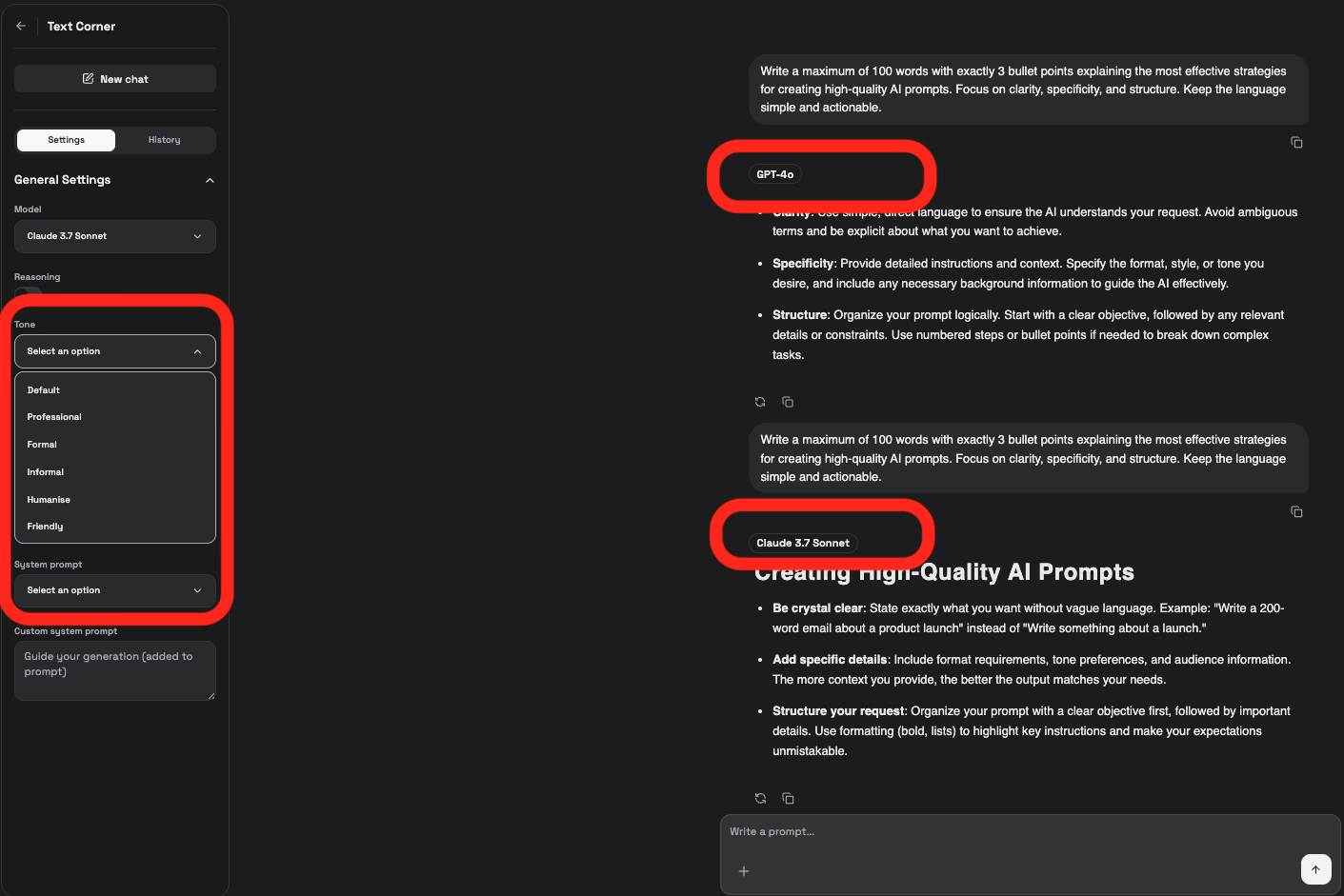How to write the best AI prompts for better results
Published on June 9, 2025 · 10 min read

AI prompting is the art of communicating effectively with artificial intelligence. It’s the skill of creating the input for AI models to deliver exactly what you need. Whether you are working on a marketing email, a content strategy, an image mood board, or a product explainer video.
All AI models, like ChatGPT, Claude, DeepSeek, or the others available on Vertical, depend on one thing to perform well: your prompt. The better your input, the better their output.
We’ll walk you through how to write prompts that bring out the best in any AI model you use.
What is AI prompting?
AI prompting refers to the process of writing instructions (read: input) that guide an AI model to produce the desired output. A prompt is a message or question you type into an AI system to tell it what you want. You’re essentially starting a conversation with the AI, but with a clear purpose in mind.
Prompts can range from a single sentence to detailed multi-paragraph instructions. And depending on the model, they can apply to text, image, video, code, or even multimodal tasks that combine several input types.
A few terms to know:
Zero-shot prompting: This means asking the AI to complete a task without giving any examples. You're relying on the model’s general knowledge to understand what you're asking.
Few-shot prompting: Here, you include one or more examples in your prompt to help guide the model’s response. This can dramatically improve results when the task is complex or open-ended.
Instruction-style prompting: This is where you clearly tell the AI what to do using direct, task-focused language. Most modern models, like those on Vertical, are especially good at following this style.
Prompting isn’t just about what you say. It’s about how you structure it, how much context you provide, and how clearly you communicate your desired needs.

Why prompt quality matters
Better prompts lead to better outputs. It's that simple. For example, some of our colleagues dedicate 75% of their time to crafting prompts and preparing input. The remaining 25% goes to fact-checking and fine-tuning the AI’s output.
Why do you ask? A vague prompt might give you a generic paragraph with no actionable insight and a lot of follow-up work.
"Write something about customer service."
Creating a clear, well-thought-out prompt takes more time. But the result is focused, relevant content you can actually use.
"Write a 5-point checklist for onboarding new customer service agents in a SaaS company. Use bullet points and keep it under 150 words."
Improving your prompt quality not only boosts the relevance and clarity of the AI’s output. It also brings other major benefits:
Productivity: Save time by getting it right the first time.
Creativity: Steer the AI toward fresh, useful ideas. Or set clear boundaries to stay focused and avoid fluff.
Efficiency: Fewer retries means fewer credits used, also important on platforms like Vertical.
10 Tips on effective prompting
Getting good results from AI is not following a magical formula. You need to be clear, intentional, and understand how AI models interpret your instructions. Whether you're writing prompts for content, code, images, or strategy, a few core principles can help you get more useful results.
Here are 10 principles to help you write the best prompt:
Define your desired output format: Want a list? A paragraph? A step-by-step guide? Say it.
Set clear parameters: Define constraints like word count, number of points, or time period to cover.
Create structural guidance: Ask for sections, headings, or bullet points if you want structured output.
Provide relevant context: Tell the AI what it's for and why it matters. Is it part of a sales pitch, a blog post, a product launch?
Specify tone and audience: Make it clear whether the output should be formal, casual, expert-level, or beginner-friendly.
Be specific with language: Avoid vague verbs like "do" or "make." Instead, say "summarize," "list," or "compare."
Eliminate ambiguous references: Ensure it is clear what is meant with every "it," "they," or "this" to avoid confusion.
Break down complex requests: Divide tasks into parts if they have multiple steps or layers.
Leverage formatting signals: Use headings, markdown, or bullet points in your prompt to guide presentation.
Iterate and test across models: Try variations, review outputs, and compare results from different models on Vertical’s marketplace.
These principles aren’t about perfection, they’re about clarity, intent, and optimization. Let’s see them in action.
Prompting in action: A case study using this article
To demonstrate these principles in a practical context, let's examine how you might craft a prompt to create this very blog post, applying our 10 principles along the way.

Phase 1: Establish clear objectives and parameters
Start by defining the desired output format and setting key parameters like word count, matching principles 1 and 2.
“Create a 1,000 word blog post explaining how to write effective AI prompts...”
Phase 2: Structure the output
Next, guide the AI on how to structure the content, following principle 3.
"...Structure the article with an introduction, two main sections (10 key principles and a practical demonstration), and a conclusion..."
Phase 3: Contextualizing the request
Provide essential context and describe the target audience so the AI understands the purpose and tone. This relates to principles 4 and 5.
"...The article targets users of Vertical's AI platform, including both beginners and experienced creators. Maintain a professional yet accessible tone..."
Phase 4: Refining language precision
Write your instructions with precise language and avoid vague pronouns or references. This aligns with Principles 6 and 7 on clear communication.
“...Avoid ambiguous pronouns. Include 10 specific, actionable principles and a practical example based on writing this article…”
Phase 5: Finalizing and optimizing
Combine each element into a single, structured prompt with formatting guidelines. This follows principles 8 and 9 about sequencing your request and guiding the output’s presentation.
Complete refined prompt:
"Create a ~1,000 word blog post for Vertical platform users about writing effective AI prompts. Include:
an introduction
a section with 10 specific principles (using numbered lists and bold highlights)
a practical demonstration section using the article itself as an example (with phase-by-phase breakdown)
and a brief conclusion.
Format with H2 and H3 headings, maintain a professional but accessible tone, and include concrete examples throughout."
Phase 6: Iteration and using different models
After receiving the initial result, the process continues. Believe us when we say that principle 10 is truly essential.
“Please add two well-structured H2 sections (What is AI prompting?, Why prompt quality matters). Each H2 section should contain no more than 150 words. Use a professional yet accessible tone aimed at AI platform users. Make the content clear and practical, and use bullet points to increase readability.”
Try your prompt with different models available in Vertical’s marketplace. Preferably you use one you already know fits your needs. For example, Claude might excel at nuanced writing guidance, while GPT-4 could offer more technical examples. Comparing outputs helps you gain experience in finding the model that best matches your intended needs.
Expert tip: Let AI create your prompt
Sometimes the easiest way to improve your prompt is to ask the AI for help. For example, if you want to create product descriptions for eco-friendly notebooks. Experiment with prompts like:
“Help me write a clear prompt to get great product descriptions. Create a list of 5 bullet points…”
Advanced models on Vertical can understand your goal and help you craft a sharp, well-structured prompt. It’s a quick way to help you get started and achieve better results.
How Vertical simplifies prompt creation and AI comparison for everyone
Even with all these best practices, prompting and model comparison can feel intimidating and time consuming. That’s why Vertical has built-in tools to help you out.
Vertical Corners are specialized environments designed for specific use cases. Whether you're writing an email, designing an image, or generating a script, you'll find intuitive dropdowns and variable settings that guide you.
Fine-tune your prompts with intuitive settings
In the text corner, you might select options like:
Tone: formal, informal, enthusiastic
Output type: professional email, step-by-step guide, pros and cons
In the image corner, choose:
Style: anime, disney, pixel
Lighting: soft, neon, moonlight
Composition: close-up, wide shot, low angle
Aspect ratio: 16:9 landscape, 4:4 portrait, 16:10 - 1280x800
Compare AI models side by side in one chat
Not sure which AI model fits your task best? Vertical Corners let you compare responses from different models side by side, in a single chat. Whether you’re fine-tuning tone, structure, or creativity, you’ll quickly see which model delivers the output that matches your needs. It’s fast, focused, and surprisingly fun.

Frequently asked questions
Why does my AI model give bad results?
Poor results often stem from vague prompts, insufficient context, or using a model not suited for the task.
How do prompts affect model performance?
Prompts guide the AI’s output; precise prompts improve relevance and quality, while unclear ones reduce accuracy and usefulness.
Can I use prompts to train my own model on Vertical?
No, prompts guide output but do not train models. Model training requires separate processes beyond prompt input.
Why should I compare models on Vertical?
Different models excel at different tasks; comparing helps you pick the best one for your specific content needs.
Does prompt length affect AI responses?
Yes, clear and concise prompts usually yield better, more relevant outputs than overly long or vague ones.




